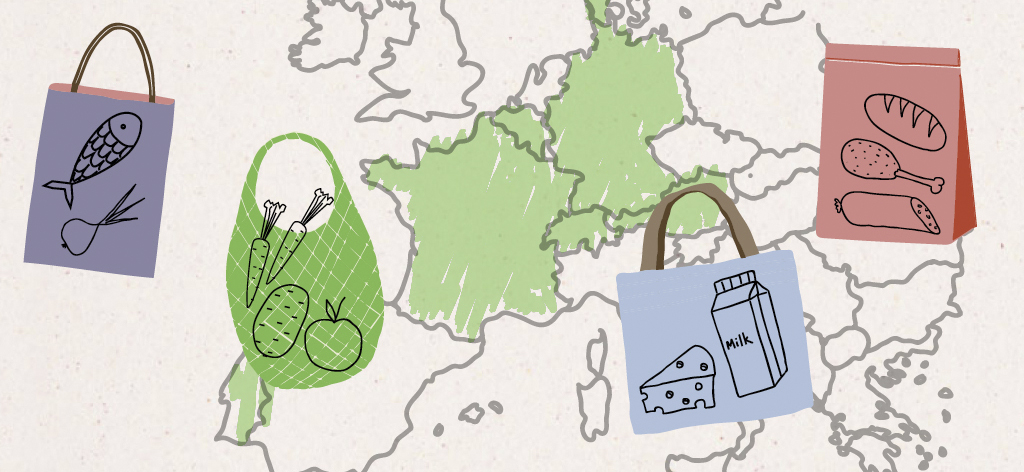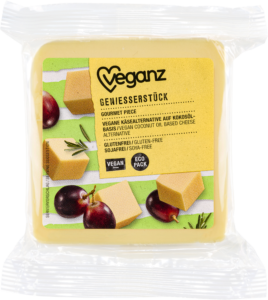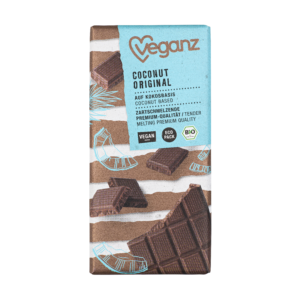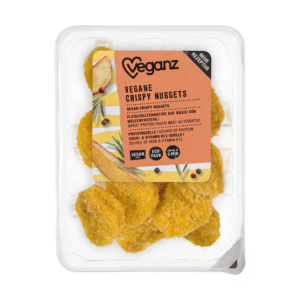Veganz nutrition study 2020
Bye-bye meat eaters!
Why do people in Europe consider themselves flexitarians? What do Europeans put on their bread and which products find their way into Germany’s shopping trollies?
On the occasion of World Vegan Day 2020, we took another good look at the eating habits of omnivores and vegans and learned more about the eating and shopping habits in those respective countries.
As early as 2019 we were already able to gain exciting insights from our first Veganz nutrition study. But our thirst for knowledge is far from quenched, which is why this year we again asked around 2,600 participants from seven European countries about their attitudes toward nutrition and environmental protection, among other things.
Among them are:
- Germany
- Austria
- Switzerland
- Belgium
- France
- Portugal
- Denmark

We conducted the study via a separate market research project, surveying participants independently of the Veganz brand appearance.
Do you also find it incredibly interesting to know what ends up on the plates in European households? Then you should follow the following pages with interest, because we have summarised the most important findings for you!
1. General Survey Information
First of all, we are particularly grateful and above all proud that over 2,600 people from 7 different countries took part – a fantastic result! What we found most interesting was discovering the kinds of food the respondents were eating. This resulted in the following representative results:
1,9 % vegan
3,1 % vegetarian
2,9 % pescatarian
22,9 % flexitarian
69,1 % omnivore
We interviewed between 218 and 518 people aged 15 to 64 from each country.
2. Vegan-Map: This is Where Most of the Vegans Live:
Not so long ago, vegans and vegetarians were viewed rather unfavourably for their choice of diet and were often ridiculed. Fortunately, this is now a thing of the past (as a rule), as people’s perception and consciousness have changed dramatically in recent years. Living vegan or vegetarian is no longer a niche phenomenon and is now more than just socially accepted.
The vegan trend is strongest in Germany. Extrapolated for the current population of 83.1 million people (as of June 2020), our study results show that 2.6 million people – around 3.2% of the population – are vegan and about 3.6 million (4.4%) vegetarians. This means – if you take the Skopos Study from 2016 for comparison – that within just 4 years, the number of vegans has exactly doubled from 1.3 million (2016) to 2.6 million.
And how about the other countries surveyed? Denmark (2.7%) and Switzerland (2.6%) ranked second and third among the countries studied. Pulling up the rear with 0.9% vegans is France.
Here is a vegan overview of all seven countries:

The following chart show in detail how many people in the 7 countries analysed belong to the different nutrition groups.
A comparison on how Europe nourishes itself:

3. The Future is Flexitarian
Flexitarians in particular are becoming increasingly the focus of attention in 2020. Why? The number of Europeans deliberately consuming meat less frequently is growing rapidly at 22.9%. Even almost 30% of Germans surveyed said they were flexitarians. In addition to omnivores, this target group is among those who, due to their size, can help minimise the urgently needed reduction of the consumption of animal products in general, but above all of meat.
These consumers provide an interesting stimulus to retail and will largely help vegan products move out of their niche.
The flexitarian trend is reflected not only in Germany but also in the other 6 countries studied. In Austria there are even a few more flexitarians, 31.8%. In Portugal 28.6% reduce their meat consumption.
Flexitarians in Europe:

The reasons for a flexitarian diet in Europe are as varied as those for a vegan/vegetarian diet. The main argument is one’s own health (51.6%), the flexitarian trend (5.2%) itself plays a rather minor role. But there is still one thing we didn’t mention: How exactly do you define a flexitarian?
According to the german society for nutrition, “flexitarians” […] also known as flexible vegetarians. They reject factory farming, want to protect the environment, promote their health but still don’t give up meat entirely “ (DGE: 10/2020).
Source: DGE: 10/2020)
ProVeg – formerly VEBU – also designates flexitarians as people who abstain from meat on at least three occasions per week.
Flexitarians and Vegans Love the Drug Store Shopping Experience
As opposed to other European countries, it’s not unusual in Germany to buy food in drug stores as well. In addition to vegans, flexitarians also like the comfort of being able to buy shampoo, dog food and tea towels, or pack one or two bars or ready meals into the shopping basket.
While on average only 25.8% of Germans shop for groceries in the drugstore, it’s 30.6% among flexitarians and even 35.5% among vegans. The latter are more likely to go to the weekly market (51.3%), the supermarket (74.9%) or the discount store (46.0%).
Another interesting fact that will perk up your ears: 59,1% of flexitarians think sustainability and environmental protection are very important when food shopping. Just 38,9% of vegans agree with this statement predominantly or entirely. Who would have thought?
But what’s also interesting to note is that no less than 57.1% of European flexitarians can imagine switching to a vegetarian and 7.9% to a vegan diet in the future. Moreover, the views of omnivores regarding a plant-based lifestyle seem to be softening. This group is also more than open-minded about the topic and 27.2% of them can imagine consuming only veggie alternatives in the future. 3.5% would even try vegan. This means that less than 42% of Europeans would still follow the omnivorous way of life. Carnivores are becoming a thing of the past. A very rosy future indeed! Even the food trend researcher Hanni Rützler from the Future Institute in Vienna is convinced that the future is in flexitarian.
“They want to eat meat, but with a good conscience.” Rützler adds: “Food will become more and more an expression of individuality. A lot of people will ask themselves: can I still swallow mountains of meat without reflecting on the consequence?” the understanding of enjoyment has changed, away from more and more, faster and cheaper. “If chicken in the supermarket is so cheap it’s almost free, I don’t want to know what they’re feeing it.”
Source: Westdeutsche Zeitung
4. Yay or Nay: In-Vitro Meat, Laboratory Cheese and Insects
European vegans have a big heart for our furry friends since animal protection is at the top of the list when asked why they don’t eat animal products. This aspect apparently does not rule out an openness to in-vitro meat etc., because in general, Europeans aren’t necessarily sceptical of the future of nutrition.
Across all nutritional groups, 20.1% of the respondents could imagine eating in-vitro meat grown in the laboratory. Specifically, that is 42% of the vegans surveyed and 30.5% of vegetarians. In the case of omnivores, only a little over 18% would consider consuming meat made from cell cultures.
This is the percentage of those who can imagine eating in-vitro meat:

In Germany, it’s mainly vegans (47.1%) and flexitarians who would try cultivated meat. There is a slight difference when it comes to laboratory cheese: 23% of the Europeans surveyed see it as a viable alternative. Especially the vegans (48%) and vegetarians (36,6%) can imagine going for a plant-based cheese alternative as opposed to flexitarians (23,7%) and omnivores with just 21,1%. The consensus is more critical, preferring to fall back on “real” cheese. But in this ranking, one must not disregard the fact that at least ¼ of those questioned are for laboratory cheese in all nutrition groups.
In Germany, by the way, 27.4% of those questioned have a positive view of laboratory cheese. More than half (55.6%) of vegans and at least 30.8% of pescatarians would be very happy to consume imitation cheese in the future.
Mealworms, crickets, grasshoppers? No way! Because 73,1 % Europeans say that insects are life forms and don’t fit in with their diet. For the other 26,9 % the little creatures represent an alternative. And how do the nutrition groups see it in detail? This is shown by our clear ranking.
Insects on your dinner plate? No way!

These figures are also reflected in Germany. Only 24% of vegetarians and 33.3% of vegans would eat insects. In general, 71.9% of Germans refrain from including mealworms and the like in their diet.
5. Vegan Europeans Want These Products
Okay, okay, we get it: Mealworms, crickets and grasshoppers aren’t very popular with Europeans. And opinions also differ on laboratory meat and cheese as conceivable alternatives. But what about a Europe-wide vegan product wish list?
If you have a look at the results of the study, you’ll see that the vegan’s wishes are:
Please! More Sausages and Cheese Alternatives as well as Baked Goods!
A whopping 45.5% of vegan Europeans (and 50.1% of Germans) miss sausage and cheese and would like to see more choice at the vegan cold cuts counter. There also seems to be a lack of vegan substitutes among sweets and snacks (Europe: 32.9%; Germany: 44.0%). Furthermore, many vegans hope that there will soon be more variety in the area of baked goods (Europeans: 38.6%; Germans: 39.4%).
Here are some of the vegan alternatives Europe would like to see:

To be honest, we were a little surprised by these results.
Dear friends: virtually all of these products are already available at Veganz – the brand for vegan product variety. So, before we start our journey through Europe with the megaphone and our delicious Veganz products, take a close look at our product range.
The vegan cheese selection alone makes our chests swell with pride. A total of seven alternatives are included in the range. Whether in slices, as a block, with cashews, for grating or spreading… to be honest, there’s truly nothing left to be desired!
We also cover the sausage and meat alternatives wonderfully. In addition to cold cuts, crispy nuggets and grillers, we also have vegan schnitzels in stock.
Mini spoiler: further alternatives to these two product groups will be added in the near future.
So, you’ve got a sweet tooth? Well, dear ones, we have so many products, we would have to list all the candy, muffins and bars. Here is a brief overview of our favourites:
And? What are you going to do now with all this data clutter?
We feel encouraged in the work we have done over the past years and equally inspired by all the input and insights – we couldn’t have done it without you. So, once again, many thanks for everything you’ve done thus far!
You want new product launches, climate protection and sustainability? So do we! That’s why we have been focusing on vegan, environmentally friendly and above all delicious new products for quite some time now and will continue to do so in the future.
Moreover, we never stop, but keep on moving forward on the slippery slope of plastic packaging – and that we will do until the search turns into a discovery and we find the best and most environmentally friendly packaging alternative for our products.
Despite the strict food standards for shelf life and storage, we are looking for solutions to reduce plastic packaging or, in the best case, avoid it completely. From a sustainability perspective, Veganz expects the packaging to be made from recycled material, preferably This means they should be certified in accordance with the guidelines of the Blue Angel, FSC-Recycled or comparable.
But we have even more up our sleeve: From compostable foil made from NatureFlexTM material or renewable raw materials such as cellulose and starch, recycled (waste) paper and PET to mineral oil-free printing inks – we are finding a sustainable package for almost every Veganz product!
In addition, we won’t stop with transparency in the food industry, which means you will continue seeing the ecological balance of our products on the packaging. This way, you can tell exactly how sustainable our items are. Accordingly, when shopping, we make it super easy for you to choose a product that is not only delicious but does something for the environment as well
Do you want to learn more fantastic facts about our nutrition study? Soon you’ll be able to get the results of the survey here.




